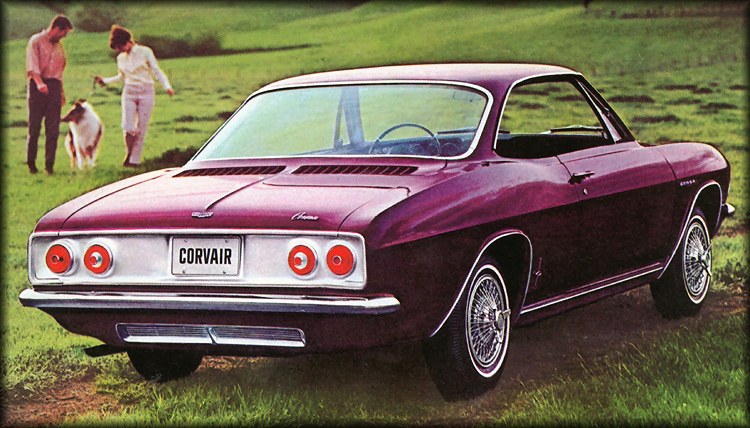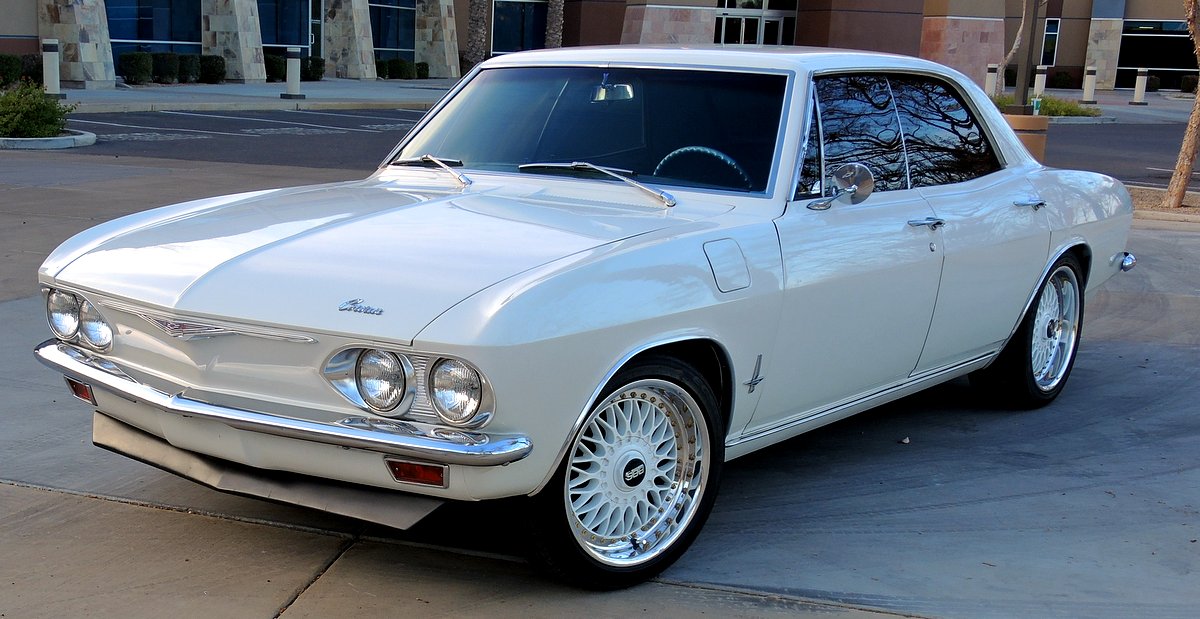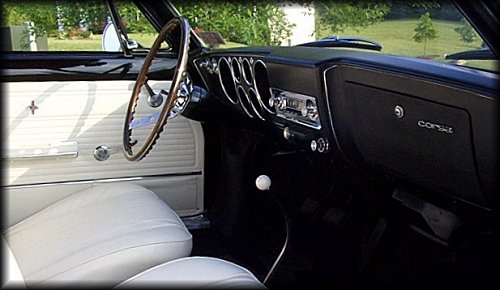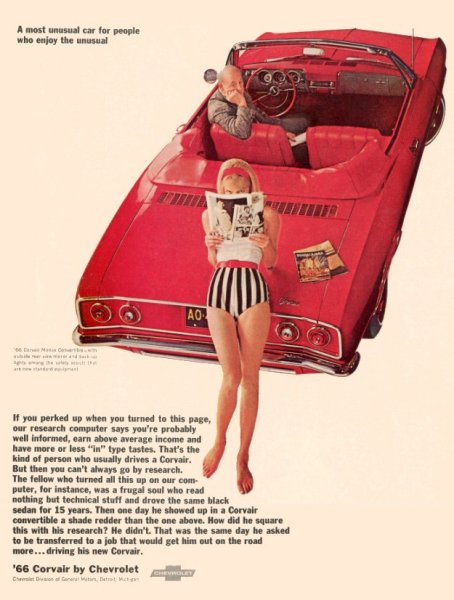I’m looking to buy a Corsa because I like the cars and want something to take to events and rallies.
I have an opportunity to get either a 140 or a 180 Turbo but have heard the the Turbo versions don’t really work all that well and are laggy.
What do you guys think?
Sent from my iPhone using Corvair Forum mobile app
Corsa 140 or Turbo
- bbodie52
- Corvair of the Month

- Posts: 11962
- Joined: Mon Aug 06, 2012 12:33 pm
- Location: Lake Chatuge Hayesville, NC
- Contact:
Re: Corsa 140 or Turbo
I tend to think that the 140 hp configuration is better for a "daily driver" car that is to be driven regularly. Both the 140 hp and 180 hp turbo engines are somewhat complicated to tune, but the turbo Carter YH carburetor and the pressure retard system on the distributor tend to have poor reliability issues. Also the turbo engine gets relatively poor gas mileage when compared with the 140 hp engine, and demands the use of expensive PREMIUM fuel. I have found that the 140 hp engine can often tolerate a mid-grade octane or even REGULAR fuel with even terrain, moderate to cool ambient temperatures, and light to moderate passenger and cargo loads. With hilly terrain, heavy loads and hot air temperatures you may have to switch to Premium fuel to avoid pinging and detonation problems.
I wrote the following material some years ago to answer similar questions from other potential new Corvair owners...
=============================================================bbodie52 wrote:Thanks. I hope my previous comments were helpful. Your comments seem to reflect interest but also uncertainty. I have worked with a number of first-time Corvair buyers in Europe who were considering a purchase of a car from USA sources (to provide a greater range of cars to consider), while knowing that such a effort would make it impossible for them to test drive or personally evaluate the car before purchasing and shipping it. Your circumstances are somewhat similar. They contacted local experienced Corvair owners and aficionados through this Corvair Forum and through local CORSA clubs, and they often found sympathetic club members who were willing to help as local "third party" volunteer assistants.
There is much to consider, and the material below is something I wrote some years ago to try to help the first-time Corvair buyer. Corvairs can be found from sources throughout the United States and Canada. I hope you will find these comments to be useful...
The Corvairs are vintage 1960s technology and design — easy to learn and easy to maintain. I would say that learning to work on a Corvair is analogous to an experienced home DIY "shade tree" car mechanic learning to work on a motorcycle. The concepts and procedures are very similar, but the details and the way it is put together is a little different. With the Corvair engine (like a motorcycle) you are dealing with a lot of aluminum. The metal is soft when compared to steel and cast iron, so the use of a torque wrench, anti-seize compound and carefully avoiding cross-threading becomes more important. Also, (like some motorcycles) you are dealing with multiple carburetors so tuning procedures are a little different. The use of Corvair shop manuals and supplements, other technical guides, and information sources like the Corvair Forum, and perhaps joining a CORSA (Corvair Society of America) club chapter can help you to quickly learn about Corvairs. Information resources, like good Corvair parts suppliers, are plentiful if you know where to look. Suppliers like Clark's Corvair Parts have been well-respected and extremely supportive since 1973, and suppliers like that make Corvair ownership more practical and much-more possible. I taught myself how to remove a Corvair powertrain, overhaul the engine, and rebuild the Powerglide transmission during my summer vacation in 1969, when I was sixteen years old. I was working alone (my father had been transferred by Lockheed from northern California to southern California, and we had not yet moved to join him). I had a shop manual and a garage full of tools. There was no Internet, no Corvair Forum, no CORSA club — I was pretty-much on my own. Yet I learned and was successful (in 1972 that engine carried me and my new bride on our wedding day and on our honeymoon).
So you should be able to master working on Corvairs without too much trouble — except watch out for rust and body rot! The Corvair is of unibody construction, so most body repair involves cutting and welding. The doors, trunk lid (in the front), and engine compartment lid (in the back)
and maybe the gas filler door are the only bolt-on body components. Everything else is cut and weld, and the body serves as the main chassis frame. So unless you are a master body repair technician, you need to select your Corvair carefully and avoid excessive hidden rust or a "Bondo bucket". The door frame areas, fenders, floor pan, the bottom of the trunk, lower windshield and battery area often rust and rot.
What follows is an attempt at introducing new prospective Corvair Owners to Corvairs and some of the issues involved. Food for thought, before you take the plunge. This is a copy of something I wrote earlier, but I think it may be helpful in your quest for the "right" Corvair...
Let us know how you wish to proceed. If you have good prospects, I urge you to seek opinions from experienced Corvair enthusiasts before you commit to a purchase. Good luck!bbodie52 wrote:I will try to provide a quick summary of the 1960-1969 Corvair lineup, and will also try to provide some answers regarding the use of a Corvair as a "daily driver".
EARLY MODEL: 1960 - 1964 Corvairs were the first generation. Their body style emulated other Chevrolet body styles from the early 1960s. The rear suspension was a swing-axle design that was similar to the Volkswagen "Beetle". The 1960 model year was the only year with a 140 cubic inch engine, and there were some characteristics that were unique to that model year only. A number of refinements were implemented in the following year, including some restyling of the front end and an increase in displacement to 145 cubic inches (CI). A manual choke was used in 1961, and this was changed to an automatic choke design in 1962 that remained with the car through 1969. A turbocharged 150 hp Spyder was introduced in 1962, and the Spyder name remained with the turbocharged engine through 1964. In 1964 the engine displacement in all Corvair engines increased from 145 CI to 164 CI. There were also some suspension refinements, including a front anti-sway bar and a rear transverse leaf spring to improve handling in all 1964 Corvairs. Here are a few pictures of Early Model (EM) 1960-1964 Corvairs...
LATE MODEL:The 1965 Corvair introduced a completely new body style, that was also seen later in similar styles in the Camaro and Pontiac Firebird. The drum brake size was increased, and the swing-axle rear suspension design used in EM Corvairs was abandoned. The new rear suspension was a design lifted from the Corvette Stingray.
1965 and 1966 Corvairs were nearly identical. In 1967-69 the top of the line Corsa was dropped, leaving the Monza and economy 500 until production was discontinued in the spring of 1969. During the 1967-69 production period, there were minor safety changes, such as a dual master brake cylinder in place of the single unit used in 1960-1966. Interior seats and trim changed somewhat, paralleling the items used in Camaros and some other GM products during that period.
All 1965-66 Corsas came with a standard 4-carburetor 140 hp engine, and an optional 180 hp turbocharged engine. The 140 hp engine remained optional in the rest of the lineup. Other engine options in the Monza and 500 were 110 hp and 95 hp dual carburetor engines. All engines could be had with a manual 4-speed or 3-speed transmission, or with a 2-speed Powerglide automatic (with the exception of the 1965-66 turbocharged 180 hp engine, which was available with the Corsa only, and only with a 4-speed manual transmission).
Air conditioning was a rare option, but can be found in the 1965-1967 lineup, and some of the EM Corvairs as well. The following link will provide you with some air conditioned Corvair background and history...
http://www.corvair.org/chapters/airvairs/
The brakes, front and rear suspension, transaxle and body were essentially identical in the Corsa, Monza, and 500. The primary differences in the cars were the instrument panel (the Corsa had more gauges), trim details, and the engine option.
The late model Corvairs were available in a 2-door Coupe, 2-door Convertible, and 4-door Sedan. In 1968, the four-door hardtop was discontinued, leaving three models—the 500 and Monza Hardtop Coupes and the Monza Convertible. Air conditioning was dropped as an option. The weight of the cars was very similar in all configurations.
Corvairs can suffer from rust and body rot problems, especially in areas that use a lot of road salt in the wintertime. While you may be able to learn and successfully attack most mechanical issues as a DIY effort, body decay can be much-more difficult, time-consuming, intimidating, and expensive to correct. So look for hidden rust or rot problems that may have been covered up with plastic filler, and be cautious in your Corvair selection.bbodie52 wrote:Here is something I wrote over a year ago — Brad's Admonition, or some words of advice — based on over 50 years of exposure to Corvair ownership — that I wrote to try to give new Corvair buyers some idea of the issues involved. I'm sure you have some idea already, but I also think this is worth considering...
Since you are new to Corvairs, I want to give you some information that I have written to other new prospective first-time Corvair owners. I have been involved with Corvairs since I was eight years old, when my parents bought our first Corvair – a brand new 1961 Monza 2-door coupe, white on red with a 4-speed transmission. I now own Corvair number ten, which I purchased in June 2012. (If you want to read a brief personal biography that outlines my family background and our experiences with Corvairs, go to CORVAIR FORUM > Introductions > New from Lake Chatuge North Carolina. viewtopic.php?f=13&t=4032 ) I want to encourage your enthusiasm in developing your plans to buy your first Corvair, but at the same time I want to help you to think through just what you are getting into. So please read and consider these comments below...
I have listened to many potential Corvair first-time owners. Many have no prior experience with owning any classic car, and many have never driven a Corvair at all, or have not driven one in decades. Some are motivated by childhood memories of a family Corvair. They typically describe the desire to locate a perfect, restored, ultra-clean example, and look to the Corvair Forum Corvair enthusiasts and aficionados to tell them what to do.
The first thing I think that needs to be done is to try to set-aside the usual emotion-based enthusiasm that any car buyer might feel when visiting a dealer and gazing with emotional eagerness at the vast array of new cars displayed in the showroom, on the car lot, and in factory brochures and advertisements. There is an extreme difference between owning a 40+ year-old Chevrolet that was likely engineered, designed and built with pre-planned obsolescence in mind — a car that GM only envisioned having a life-span of ten years or so. Many of the potential Corvair buyers are captivated with the exciting idea of owning something different — something not normally seen on the road — something that your neighbor will not buy! Certainly that is the case with a Corvair, but owning a Corvair and enjoying that ownership demands a certain dose of reality before you "buy-in". Many are unprepared for the maintenance and upkeep demands of a Corvair. "Where can I find a good Corvair mechanic?" is a common question — often displaying an inability or unwillingness to do some mechanical work and maintain that car yourself. Yet qualified Corvair mechanics can be distant, expensive, inconvenient, and all-too rare. At a time when finding even a spark plug, fan belt, or oil filter for a Corvair often means an Internet or mail-order purchase, finding local support may be unlikely or impossible. Even searching automobile junk yards will often not help, because these cars are so rare and infrequently found that they have all but disappeared from the scrap yards too. Even locating and buying a used part is a mail-order proposition. And even if you spend $15,000-$20,000 for a fully-restored Corvair in mint condition, it still comes "as-is", with no warranty and little in the way of a local support system — far different than what most car buyers are used to expecting! These are the realities of owning an older classic car.
Corvairs are popular and affordable classic cars, and enjoy a good infrastructure of maintenance supporters, owner's clubs, and parts suppliers — and that REALLY helps! But I suspect that most happy Corvair owners are something of "shade-tree mechanics" and hobbyists who are prepared to deal with the risks and problems related to Corvair ownership. It requires a long-term commitment and a dose of reality to happily own a classic Corvair. The "first date" infatuation with the attractiveness and uniqueness of a Corvair will not sustain you in a long-term relationship with a Corvair. It is far-better to have a realistic idea of just what you are getting into before you "take the plunge" and buy your dream car.
A cautious, knowledgeable and educated search for your dream Corvair is a great start, and a careful and realistic analysis of your own mechanical talents, skills and abilities is also useful. If you plan to have a mechanic do most of the work for you, the availability of a Corvair-skilled mechanic and the associated costs involved must be taken into account in your financial planning to own a Corvair.
I try to not be too negative, but I have worked with others who came to realize that Corvair ownership was more than they could handle. I just feel that new prospective Corvair owners come here to this forum to learn from others who have more experience, and we are not doing them any favors by "candy coating" the issues involved. If they pass the "sanity check" and still want to pursue buying a Corvair, then GREAT! This Forum and perhaps some local Corvair club members can potentially help them pursue that dream. But it should be a realistic dream, and not a frustrating "nightmare" experience. Better to make a clear-headed, informed decision early in the game!
I hope that these comments are useful to you. I know I get "long-winded", but I also know you are trying to make an important decision, and I hope all of these comments will help you.
A Corvair can serve well as a daily driver. But I would recommend a backup car or other alternatives, since ANY breakdown can put the car out of service for days until replacement parts can be obtained (if needed). If you have the skills and ability to work on the car yourself, repairs can often be completed fairly quickly. But if you have to rely on professional mechanics, downtime can be long and possibly expensive — if you can find a good mechanic to do the work for you.
The link below will provide you with a list of useful websites that are Corvair-related. Some of the links will lead you to an extensive technical library that will allow you to download shop manuals and other technical references in Adobe Reader format at no cost. There is also a link that will help you to locate nearby CORSA (Corvair Society of America) club chapters. While the Corvair Forum can be very helpful as you work on your Corvair, having local friends and contacts in your region who are knowledgeable about the Corvair can also be very helpful. These family-friendly CORSA chapters often offer picnics, group scenic drives, technical training and assistance, car shows, and competition events that can greatly enhance your enjoyment of Corvair ownership. You will also find a list of essential Corvair parts suppliers.
Common and Useful Corvair Websites
Brad Bodie
Lake Chatuge, North Carolina
 1966 Corvair Corsa Convertible
1966 Corvair Corsa Convertible
Lake Chatuge, North Carolina
 1966 Corvair Corsa Convertible
1966 Corvair Corsa ConvertibleRe: Corsa 140 or Turbo
As a 180 owner I am partial to my 53 year old turbo. Cool technology for back them and the platform leaves plenty of opportunity for improvement with modern day gear. I guess that’s true with either platform, but I like the challenge the turbo complexity adds. Building a 140 for autocross though, so somewhat depend on your planned usage.
Sent from my iPhone using Corvair Forum mobile app
Sent from my iPhone using Corvair Forum mobile app







